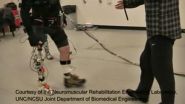(Press-News.org) VIDEO:
Powered lower limb prosthetics hold promise for improving the mobility of amputees, but errors in the technology may also cause some users to stumble or fall. New research from the...
Click here for more information.
Powered lower limb prosthetics hold promise for improving the mobility of amputees, but errors in the technology may also cause some users to stumble or fall. New research examines exactly what happens when these technologies fail, with the goal of developing a new generation of more robust powered prostheses.
"My work has focused on developing technology that translates electrical signals in human muscle into signals that control powered prosthetic limbs - such as decoding muscle signals to tell a prosthetic leg that it needs to walk forward or step up onto a staircase," says Dr. Helen Huang, senior author of a paper on the work and an associate professor in the joint biomedical engineering program at North Carolina State University and the University of North Carolina at Chapel Hill.
"But sometimes this 'decoding' technology makes mistakes, such as thinking someone wants to climb a step when he doesn't," says Fan Zhang, lead author of the paper and a Ph.D. student in the joint biomedical engineering program. "This is a problem, because we don't want to put users at risk of stumbling or falling."
Huang's team set out to understand exactly what happens to users of powered prosthetic legs when there's an error in the decoding technology.
VIDEO:
Powered lower limb prosthetics hold promise for improving the mobility of amputees, but errors in the technology may also cause some users to stumble or fall. New research from the...
Click here for more information.
"We not only want to improve the decoding accuracy, but determine which errors are important and which have little or no impact on users," Huang says. "Understanding the problem is an important step in finding ways to make these prostheses more reliable."
To address the issue, the researchers had study subjects use a customized prosthetic device that was programmed to make errors. This was done in a lab setting that allowed Huang's team to monitor each user's balance and biomechanics. Users were also asked how stable they felt during each trial.
The researchers found that some errors were so insignificant that users didn't even notice them - particularly errors that were short in duration or that occurred when a user's weight was not being applied to the prosthetic leg.
But errors that lasted longer, or that occurred when a user's weight was on the prosthetic limb, were more noticeable. The researchers also determined that critical, or especially noticeable, errors were also characterized by a large "mechanical work change," meaning the prosthetic limb thought it had to do significantly more or less work than the user intended. Video of a "stable" test can be seen at https://www.youtube.com/watch?v=ZFka6AgrKdg&feature=youtu.be. Video of an "unstable" test can be seen at the top of the page, or at https://www.youtube.com/watch?v=-BnCa0cqZMg&feature=youtu.be.
"One of the things we'll be doing as we move forward with this work is seek ways to limit that mechanical work change," Huang says.
"Any system that involves a human interface will have occasional errors," Huang notes. "But we think we can find ways to make those errors effectively insignificant."
INFORMATION:
The paper, "Effects of Locomotion Mode Recognition Errors on Volitional Control of Powered Above-Knee Prostheses," is published in early view online in the journal IEEE Transactions on Neural Systems and Rehabilitation Engineering. The paper was co-authored by Ming Liu, a laboratory manager in the joint biomedical engineering program. The work was supported by the National Science Foundation under grants number 1406750 and 1361549, by the Department of Defense under grant number W81XWH-09-2-0020, and by the National Institute on Disability and Rehabilitation Research under grant number H133G130308.
Bethesda, MD (Nov. 21, 2014) -- Cirrhosis and nonalcoholic fatty liver disease (NAFLD) are two serious liver conditions with limited pharmacological treatments. The December issues of AGA's journals -- Clinical Gastroenterology and Hepatology and Gastroenterology -- highlight important updates into treatments for these two debilitating diseases.
For access to any of these studies, or to speak with the study authors, please contact media@gastro.org or call 301-272-1603.
Promising Probiotic for Liver Disease
A study published in Gastroenterology1 found that, over a ...
EAST LANSING, Mich. --- Don't get along with your boss? Your job performance may actually improve if the two of you can come to grips with the poor relationship.
A new study led by Michigan State University business scholars finds that workers are more motivated if they and their supervisors see eye-to-eye about a bad relationship than if they have different views about their relationship. The findings are published in the Academy of Management Journal.
"Seeing eye-to-eye about the employee-supervisor relationship is equally, if not more important than the actual quality ...
SCOTTSVILLE, SOUTH AFRICA-- Worldwide, drought conditions, extreme temperatures, and high soil saline content all have negative effects on tomato crops. These natural processes reduce soil nutrient content and lifespan, result in reduced plant growth and yield, and ultimately translate to lower profits for tomato producers. As an alternative to unsustainable practices such as the use of synthetic fertilizers, producers are looking to environment-friendly soil ameliorants such as verimcompost leachate, an organic liquid produced from earthworm-digested material and casts ...
TUSCON, AZ - Soil solarization, a process that uses solar radiation to rid the soil of pests, is most common in regions with high solar radiation and high temperatures during the summer season. An alternative to soil fumigation, the process is used either alone or in combination with fumigants. To accomplish solarization, solar radiation is used to passively heat moist soil covered with clear plastic sheeting, with the goal of increasing soil temperatures to the point where they are lethal to soilborne organisms. The effectiveness of solarization is based on the actual ...
Quebec City, November 21, 2014--Scientists from Université Laval, the University of British Columbia and the University of Oxford have discovered a natural resistance gene against spruce budworm in the white spruce. The breakthrough, reported in The Plant Journal, paves the way to identifying and selecting naturally resistant trees to replant forests devastated by the destructive pest.
A research team composed of professors Éric Bauce, Joerg Bohlmann and John Mackay as well as their students and postdocs discovered the gene in spruces that had remained relatively ...
Employees who work at small, locally owned businesses have the highest level of loyalty to their employers -- and for rural workers, size and ownership of their company figure even more into their commitment than job satisfaction does, according to Baylor University researchers.
Higher levels of commitment are associated with less absenteeism, lower turnover and less seeking of jobs outside the company. The study -- "Small, local and loyal: How firm attributes affect workers' organizational commitment" -- is published in the journal Local Economy.
"It's an interesting ...
LA JOLLA, CA - November 20, 2014 - Scientists at The Scripps Research Institute (TSRI) have discovered how one gene is essential to hearing, uncovering a cause of deafness and suggesting new avenues for therapies.
The new study, published November 20 in the journal Neuron, shows how mutations in a gene called Tmie can cause deafness from birth. Underlining the critical nature of their findings, researchers were able to reintroduce the gene in mice and restore the process underpinning hearing.
"This raises hopes that we could, in principle, use gene-therapy approaches ...
There are plenty of body parts that don't grow back when you lose them. Nails are an exception, and a new study published in the Proceedings of the National Academy of Sciences (PNAS) reveals some of the reasons why.
A team of USC Stem Cell researchers led by principal investigator Krzysztof Kobielak and co-first authors Yvonne Leung and Eve Kandyba has identified a new population of nail stem cells, which have the ability to either self-renew or undergo specialization or differentiation into multiple tissues.
To find these elusive stem cells, the team used a sophisticated ...
Stress activates the immune system
The team focused mainly on a certain type of phagocytes, namely microglia. Under normal circumstances, they repair synapses between nerves cells in the brain and stimulate their growth. Once activated, however, microglia may damage nerve cells and trigger inflammation processes. The studies carried out in Bochum have shown that the more frequently microglia get triggered due to stress, the more they are inclined to remain in the destructive mode - a risk factor for mental diseases such as schizophrenia.
Susceptibility for stress effects ...
A protein kinase or enzyme known as PKM2 has proven to control cell division, potentially providing a molecular basis for tumor diagnosis and treatment.
A study, led by Zhimin Lu, M.D., Ph.D., professor of neuro-oncology at The University of Texas MD Anderson Cancer Center, showcased the non-metabolic abilities of PKM2 (pyruvate kinase M2) in promoting tumor cell proliferation when cells produce more of the enzyme.
The study results were published in today's issue of Nature Communications.
Dr. Lu's group previously demonstrated that PKM2 controls gene expression ...







